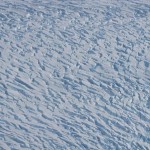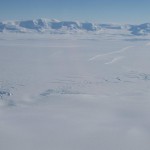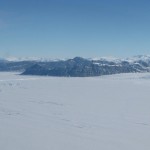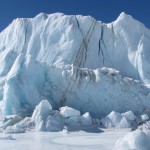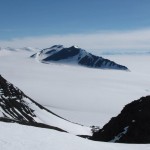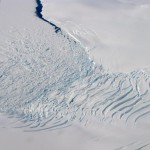George VI Ice Shelf is a floating ice shelf between Alexander Island and the Antarctic Peninsula. This webpage is based on:
George VI Ice Shelf
Alexander Island and George VI Ice Shelf is an unusual area, and the ice shelf is worth investigating for several reasons. For a start, it’s unusual, being trapped between the mainland and Alexander Island (see map below), and secondly, because it’s right on the -9°C mean annual air temperature isotherm (like a contour, but of mean annual air temperatures).

Some people have argued that this mean annual air temperature is the critical threshold above which ice shelves may dramatically collapse, which has implications for accelerated flow of glaciers and ice-sheet thinning. Ice shelves are also susceptible to warming from below by warm currents penetrating onto the continental shelf. So, research into this important part of the peninsula is always welcome.
Holt and colleagues have just completed a study (open access) that investigates the response of George VI Ice Shelf (shown in the image below) to environmental change (i.e., oceanic and atmospheric temperature variations), and offer an assessment as to its future stability (Holt et al., 2013).

George VI Ice Shelf is approximately 24,000 km2 and is the second largest ice-shelf on the Antarctic Peninsula. The northern ice front calves into Marguerite Bay, and the southern ice front calves into the Ronne Entrance, where there are several ice rises (Holt et al., 2013), which are bedrock highs on which the ice front is grounded and pinned.
Along its centreline, this means that the ice shelf is around 450 km long, and is around 20 km wide and 100 m thick in the north, 600 m thick in the centre, and 75 km wide in the south. Ice flows from both Alexander Island and the Antarctic Peninsula into the ice shelf. The ice shelf primarily loses mass (ablates) as a result of calving at its termini and basal melting.
The ice shelf is unusual, because it is grounded at the margin against Alexander Island; unlike the Larsen Ice Shelf, which flows freely into the ocean, George VI Ice Shelf is laterally constrained. Here, it dams epishelf lakes in Ablation and Moutonnee valleys.
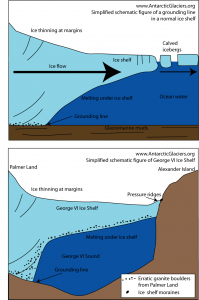
Ice shelf thickness and freeboard
The freeboard (height of the ice-shelf surface above sea level) of George VI Ice Shelf ranges from ~60 to 5 m asl. The ice shelf is structurally complex, with distinct flow units originating in Palmer Land flowing across to, and impinging against, Alexander Island (Davies et al. 2017; Reynolds and Hambrey, 1988; Hambrey et al., 2015).
Ice-shelf thickness and freeboard is controlled by this complex flow regime. Ice-shelf thickness varies from 100 m at the northern ice front to 600 m in the centre, before thinning again towards the southern ice front (Davies et al. 2017; Lucchitta and Rosanova, 1998; Smith et al., 2007).
The thickest ice occurs in lobes extending from the grounding-lines of the major outlet glaciers from Palmer Land. Thicknesses adjacent to Ablation Point Massif are c. 125 m (Hambrey et al., 2015), and the ice-shelf surface is 5 m asl here. In the centre of George VI Sound near Ablation Point Massif, the ice shelf reaches up to 150 m thick. The ice shelf reaches a surface elevation of ~20 m asl at Fossil Bluff, with a thickness of ~200 m.

Structural Glaciology
Holt et al. used Landsat images to map the surface features of ice shelves on the south-western Antarctic Peninsula. They mapped the ice front, grounding zone, longitudinal surface structures (flow stripes), pressure ridges, crevasses, fractures and rifts, surface meltwater, ice dolines, ice rises and ice rumples.
Together, these data help us to understand the structure of more ‘stable’ ice shelves, and helps us to assess their likely future response and vulnerabilities to climate change.

The photographs below show the northern part of George VI Ice Shelf from above.
Ice shelf collapse
Holt et al. comment that ice-shelf collapse is usually preceded by:
- sustained ice-front retreat, with a frontal geometry that bows inland (ice shelves are more stable where they are ‘pinned’ against the land, at their lateral margins) (Doake et al., 1998);
- continued thinning from below and above by atmospheric and oceanic warming (Fricker and Padman, 2012);
- increasing flow speeds;
- and finally, structural weakening along suture zones (where ice shelves or glacier ice meets) (Glasser and Scambos, 2008).
- Meltwater ponding on the ice surface is also critical, because hydrofracture may drive rapid ice-shelf break up.
This research is aiming to investigate whether George VI Ice Shelf is at risk of collapse. Ice shelf collapse has a significant effect on the glaciers inland, causing them to accelerate and discharge ice into the ocean.

Changes in George VI Ice Shelf
Holt and others (2013) conducted an extensive analysis of ice shelf velocity, structural glaciology, recession, thinning and grounding-zone retreat. They found that the ice shelf is retreating at an annual rate of around 1.0 km (1936-1974) to 1.1 km per year (1974-2010).
However, recession of this particular ice shelf generally occurs during a limited number of periodic, large-scale calving events, with a two-phase recession recorded from 1974-2010 (Holt et al., 2013). Calving events followed the gradual development of large, deep rifts, with a large calving event in January 2010.
Ice rifting
Much of the ice-shelf recession is therefore controlled by long-standing rifts in the ice, which develop many years before the calving event. Rifts are structurally controlled, with areas of rifted ice occurring between different flow units of the in-flowing glaciers.
In the northern part of the ice shelf, the ice flows under an extensional regime and does not undergo longitudinal compression following rift formation. Fractures that therefore originate where glacier ice flows into the ice shelf therefore continue without impediment towards the northern end of the ice shelf, where they form large rifts, making the northern end susceptible to large, periodic, calving events.
The southern margin of George VI Ice Shelf is steadily receding (Holt et al., 2013), with recession concentrated in the centre of the ice front, where the ice is thinnest. The islands on which the ice shelf is pinned cause regular fracturing and rifting as the ice flows over and around them, as the ice shifts from compressional stresses to tensile stresses downstream. The ice rises also cause ice flow to slow around them, so they effectively act as an impediment to smooth flow.
Ice shelf acceleration
Parts of the ice shelf are now flowing faster. Recession of the most northerly margin has reduced the backstress and buttressing effect on Riley Glacier, on the Antarctic Peninsula, which is now flowing faster. In the south, the removal of large areas of ice has led to increased longitudinal extension, causing more fracturing and increased ice velocities (Holt et al., 2013).
Glacier thinning
One method of calculating elevation change is to use ICESat data. This satellite measures ice surface elevation, and repeated tracks show elevation change through time. Holt et al. analysed ICESat data across George VI Ice Shelf to show surface elevation change from 2003 to 2008.
Significant thinning was observed in the southern section of the ice shelf, which is coupled with widespread recession of the ice front terminus.
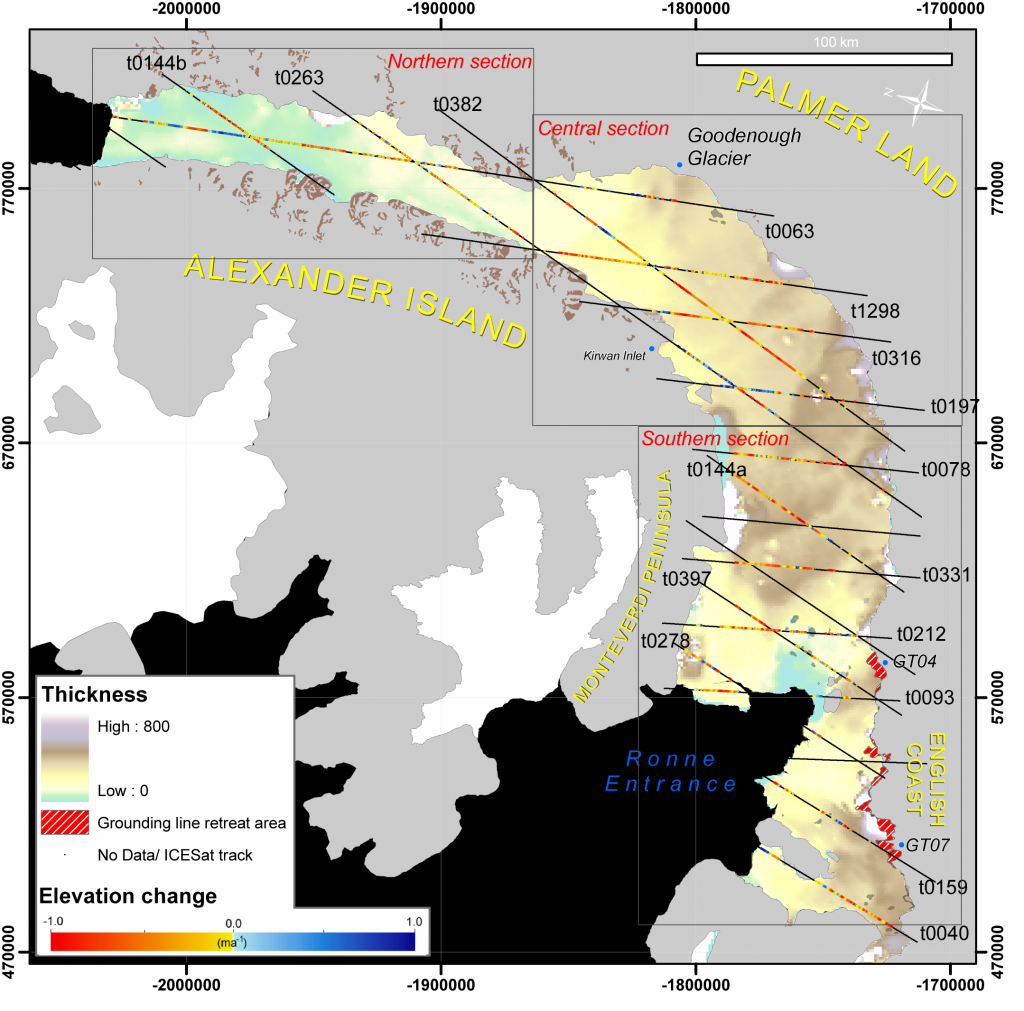
Future stability
The northern end of George VI Ice Shelf is currently free from large crevasses, which take several decades to form. No large-scale rifting is therefore immediately expected from this area. However, it has changed considerably over the last 40 years, and response to continued environmental change is expected (Holt et al., 2013).
Surface melt is prevalent on the ice shelf, and continued longer, warmer summers and more meltwater ponding may result in ice-shelf recession by hydrofracture, where meltwater ponds melt downwards through the ice, weakening it structurally and contributing to increased iceberg calving.
The southern ice front of the ice shelf has changed rapidly following climatic and oceanic changes, with sustained recession, mostly in the thinner central portion. This part of the ice shelf is structurally weak and prone to iceberg calving. The ice shelf is thinning following increased basal melting from the incursion of warm waters beneath the ice shelf. This part of the ice shelf is therefore very vulnerable.
Further reading
- Ice shelf collapse
- Antarctic ice shelves: the hidden villan
- Antarctic Peninsula glacier change (and Prince Gustav Ice Shelf collapse)
- Glaciers and climate change
- Marine Ice Sheet instability


